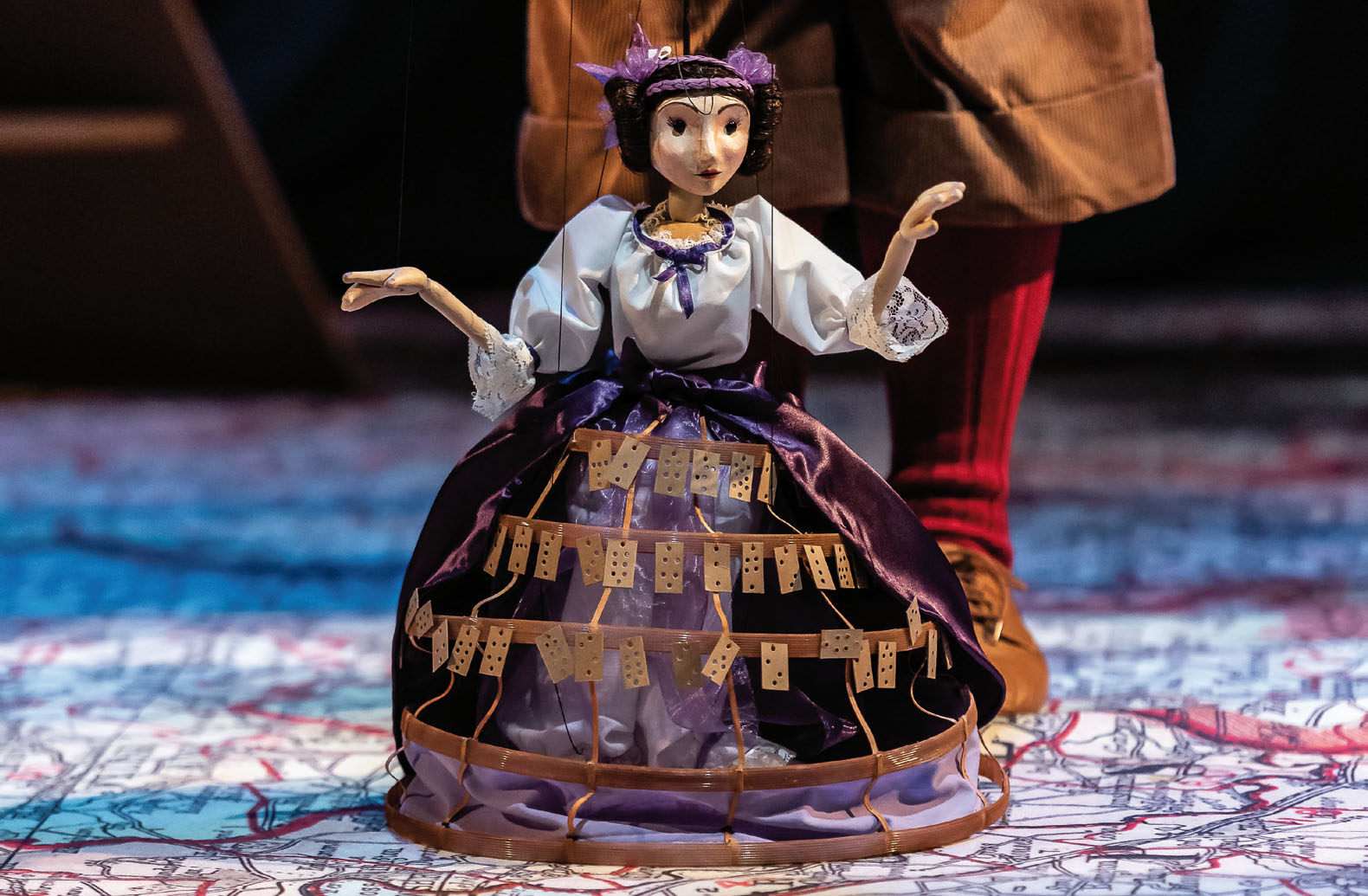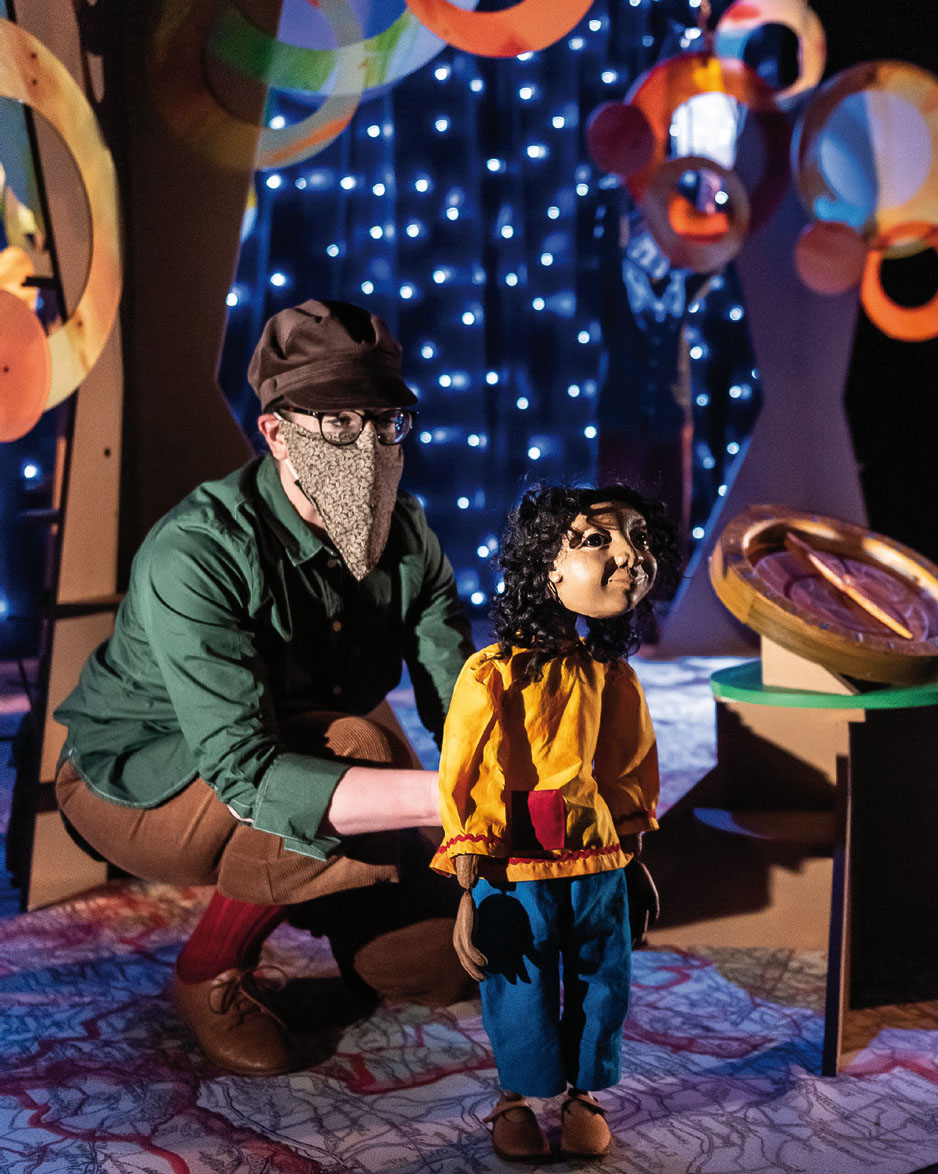STEM sisters: Asking questions, finding answers
Hattie Fisk
Saturday, May 1, 2021
Jina and the STEM Sisters, the new film from HMDT Music, was originally designed as a touring puppet show to educate primary school students on forgotten women in science. Hattie Fisk spoke to director Claire Whistler and creative director Tertia Sefton-Green about the challenges of their move to digital, and their plan to perform in person again this summer
'Science and everyday life cannot and should not be separated.’ This quote from Rosalind Franklin is displayed brightly on the STEM sisters resource page, sitting within a rolling stream of quotes from monumental women across history. HMDT Music took this quote literally, embedding science in a colourful performance, meshing types of puppetry, genres of music, and periods in history to create a vibrant display of discovery for primary-aged students.
The story follows budding scientist Jina as she adventures through a forest, finding her way with the help of some of the most amazing female scientists and mathematicians in history. She is gifted with five traits that help find her way home: curiosity, courage, creativity, persistence, and open-mindedness.
If you thought merging puppets, singing and science was an unusual choice, you would be right. It is bold, but the outcome is a delightful and informative production for schools and families alike. Forming a sisterhood of scientists, this puppet-driven performance is designed to educate children about the unsung heroes of STEM; each compelling story has a musical number to go with it, making this an audio-visual learning experience. I spoke to director Claire Whistler and creative director Tertia Sefton-Green about their excellent creative choices, and how they overcame challenges as educators in the past year.
‘An echo’
The cast, production team and all the fictional characters are women – a rare thing, even in 2021. Director Claire Whistler comments on this, explaining that ‘there's not a single masculine energy in the piece’. She says: ‘I don't think it suffers for that. It is being very clear: look at these amazing women in different times and in different situations.’ She urges that ‘It doesn't matter if they are female or male. It's about their successes and it needs to be talked about’. Proudly she laughs: ‘I quite like the idea of boys watching too’.
Despite creating a liminal space where women from history can congregate, an important element of the performance was the real-world relatability for the young audience. An element that reinforces this was the integration of a children's chorus from I Can Sing!. The production's composition involved devising workshops over zoom with the children, some of whom had little to no musical experience. There they collaborated with composer Jenny Gould, who incorporated their fresh ideas into the music, culminating in a socially distanced recording session where the chorus was created.
Another element of the performance that brought the fictional story into the realm of reality, was in Marie Curie's performance. The puppet dreamily displays real footage of modern-day scientists in a lab, depicting what current women in science look like. Crucially, this element links to the reality of modern medicine, and is, as Whistler described it, ‘an echo of what [children] might see in their school – it means it's close to them.’
Interestingly, the creators didn't just show each scientist's success, but instead made the creative decision also to include their failures and sacrifices for science. They narrated Hypatia being stoned to death and Marie Curie dying of radiation poising, among other bold stories. Whistler explains that it was a choice they made to emphasise that ‘It's hard work. It's not just “I can decide to become a scientist and discover things”. It is “I have to work and maybe have to sacrifice things”.’
The production remains overwhelmingly positive, despite the inclusion of some darker elements. As each character helps Jina navigate a confusing map on the floor of the stage, Whistler highlights the importance of this feature: ‘it was that whole idea of being lost and how to find our way, and how she finds her way through these wonderful visitations from these female scientists with all these gifts.’
Describing the women as having ‘incredible eccentricities’, Whistler adds that possibly ‘that is what they had to be to rise in their situations at the time’, overcoming gender inequalities and navigating societal isolation.
Adapting as an educator

© Clive Barda
Ada Lovelace, the first ever computer programmer
As a production that faced a huge shift from a physical performance into a film, the creators of the show, like so many others, felt the impact of Covid-19 regarding educating children. With the original plan to pair each performance with two educational workshops run by real female scientists, the team behind STEM sisters has had to ‘ask questions’ and ‘find answers’ as their protagonist Jina helpfully reiterates.
Sefton-Green, the project's creative director and self-professed perfectionist, explains that throughout the past year ‘a really big lesson is actually it can be good enough even if it's not what you wanted it to be. You have to celebrate what you have been able to achieve compared to what you would have liked to be able to achieve. The kids come up with so many ideas and things that they want to do – so it is about listening as well.’
HDMT Music urge drama teachers and practitioners across the country to use the limitations thrown at them throughout the past year as creative springboards. Sefton-Green says that ‘It has been a really tough year for everybody, but it has also sort of shown our flexibility and potential. We have found that anything is possible.’ Whistler agrees, adding that we should strive to ‘be original and open to what can be done’ while respecting the boundaries we must at the moment.
Celebrating the forgotten women in STEM
 © Clive Barda
© Clive Barda
Puppeteer Ruth Calkin and protagonist Jina with Hypatia's astrolabe
Voicing the work of unsung heroines, Sefton-Green unpicks the process behind choosing the scientists the production featured. She explains that they started by looking at the curriculum, ensuring that each scientist was recognised academically in schools. She states that because of focussing on the curriculum they ‘missed out lots of wonderful people. Within that we had to look at diversity, history, different scientific genres… the invention as well as astronomy, physics etc.’. She describes the process as ‘a lot of trial and error’, always returning to those five key attributes Jina is gifted, believing that while they are ‘core to science, they are also core to everything’.
Sefton-Green elaborates on the message of the performance, explaining that while the production focuses on women in STEM, the essence of the show is universally relevant. ‘You don't have to be at the forefront’ she explains. ‘Some of us want to be performers – but some of us don't. Some of us want to be stage managers putting it together, and you can't have one without the other.’ The idea that an element of your work can contribute to something, and ‘you might not be recognised in your lifetime’ is something that children may not have heard before. The creative director reminds us that ‘celebrating is the easy bit! It is the difficult bit [they] wanted to show’. In terms of this message, and regarding gender, this production is ground-breaking.
The performance is set to tour this summer, with each visit accompanied with two workshops run by real female scientists. A science communicator on the project, Jules Pottle, said: ‘learning more about Mae Jemison, in particular, was a delight. Like me, she believes that the arts and sciences are both creative and belong together.’
There is a cyclical theme to the production, in the repeatedly catchy chorus refrain, a set made from circular trees, and a large silhouette of the moon lighting up the stage. I think the message that positive moments in history can repeat themselves in the youngsters watching the performance is a touching one, and truly embeds a sense of excitement in what the audience have to offer the world. The ‘gifts’ Jina holds are truly applicable to all children and all career paths.
Hypatia, the first scientist we meet, graciously comments ‘reserve your right to think, for even to think wrongly is better than not to think at all’. I hope this production continues to inspire educators and young audiences, reinforcing that trial and error is a crucial element of success, and that STEM and theatre can cross paths.
For more information or if your school would like to take part, contact: stemsisters@hmdtmusic.org.uk
To access their free education resources on the women in STEM, visit www.hmdt.org.uk/hmdtmusic/stemsisters

